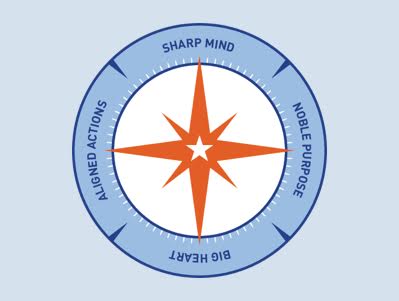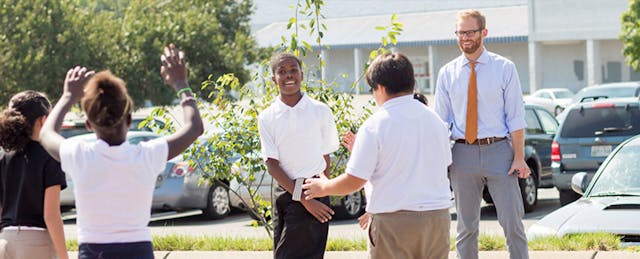Jack stood face-to-face with Sergio, surrounded by a circle of twenty other sixth grade boys. The room was thick with emotion as their teacher, Ms. McShea, thought to herself, “Uh oh, this may not go well.”
But they weren’t there to fight. Jack asked Sergio to the center of the circle to work on their relationship. Sergio’s relentless fidgeting in class drove Jack crazy, and Jack was beside himself. The boys were agitated, but they followed a relationship work protocol—one that’s taught to every student at Valor Collegiate Academy in Nashville, TN. As the conversation became safe, Sergio shared that he struggled with an attention disorder, a disclosure that further softened their stances. Jack and Sergio soon began brainstorming relaxation and attention-building exercises that they could do together before classes so they could both feel more calm.
In its inaugural year, Valor’s fifth graders had the strongest performance on state tests of Nashville’s 180 schools—an accomplishment that CEO Todd Dickson attributes to the foundation set by the school’s social emotional learning (SEL) program. “We are trying to build a school where social-emotional skills are just as important as academics,” he says.
But how does a school system achieve that?
The Importance of Social-Emotional Learning
Valor Collegiate Academies is a Nashville public charter school network that serves 510 students across two schools in grades 5-6 (expanding to grades 5-12). 52 percent of Valor students are low-income, and 24 percent are English Language Learners. The school has an explicit mission to serve a diverse student body and its population is currently 35 percent white, 20 percent Latino, 20 percent black and 20 percent Middle Eastern.
Valor believes in personalized learning and wants its students to be self-directed, but instead of purchasing adaptive software or knocking down classroom walls, it developed one of the most comprehensive SEL programs in the country.
“Children’s capacity for social emotional learning is far greater than we imagine. It’s hard to keep up with them,” observes Daren Dickson, Todd’s twin brother, Valor’s Chief Culture Officer and the mastermind behind Compass, the school’s SEL program.
Students devote a minimum of four hours a week over eight years to Compass—a massive commitment.
As a psychotherapist, Daren spent more than a decade serving children who fell through the cracks of our schools, hospitals and child welfare systems. He believes that emotional safety, healthy relationships, and the ability to live a balanced, purpose-driven life are essential. “But kids are usually only taught these skills once they are in real trouble. Every child needs these skills to have a good life,” he says.
Here is how Compass works.
Compass in Action
Compass refers to a student’s “inner compass,” which Valor defines as having five dimensions: Noble Purpose (values and identity), Sharp Mind (curiosity and diversity of thought), Big Heart (courage and kindness) and Aligned Action (determination and integrity) with Truth North (balance and presence) lying at the center. The dimensions are pictured in the image below.

The Compass program is organized around two basic experiences: 1) mentor groups comprised of 22 students and a teacher who meet for a full hour twice a week during their 8 years at Valor; and 2) individualized Compass plans where students demonstrate mastery of skills in each of the five Compass dimensions.
Much of the “magic” happens when mentor groups meet in Circle, a highly structured and ritualized process illustrated by Jack and Sergio in the example listed above.
Students use Circle to build and repair relationships. While Jack and Sergio discussed classroom difficulties, other students resolved lunchroom conflicts, shared stresses at home and processed a major health issue faced by a classmate. In each case, two students stood up and met face-to-face in the middle of the circle to engage in dialogue.
Standing face-to-face with a classmate and being vulnerable in front of peers can be daunting, but the structured Circle process allows teachers who are not experts in SEL to successfully facilitate student interactions and, over time, students build the skills to facilitate Circle themselves.
Circle is also where students present their progress on their individualized Compass plans. Students make progress on their plans by mastering skills in each of the five dimensions and presenting to their peers for approval. For example, students construct and present their life stories as part of the Noble Purpose goal of building identity. Other students might engage in daily exercise for 30 days to earn a badge for Aligned Action.
Students earn badges, similar to the Boy Scouts, for mastering individual skills. When students have accumulated enough progress, their mentor groups can approve them to graduate to the next phase of personal development of which there are five overall. Every student must approve for the advancement to happen.
Assessing Compass’s impact
Compass’s impact on students is immediately visible in classrooms. The strong relationships Compass forges between students, teachers and administrators sets the stage for deeper learning, especially in the context of Valor’s diverse student population.
During a social studies lesson on the Jewish diaspora, Mr. Hopper asked his sixth graders, “Do you have an example where you moved to a different country and had to learn a new language?” A Sudanese girl leaned forward while a Kurdish boy described his family’s journey from Iraq to Turkey to Boston to Nashville and the different cultures his family adopted. Another boy shared that his family moved from Mexico to Nashville and they lived in a trailer for years after their arrival. Instead of laughing or making fun of their classmate, students silently wiggled their fingers in the direction of the boy as if casting spells. “Send him some love,” said Mr. Hopper as the rest of the class joined in.
Valor principal Travis Commons notes that, “We make [Compass] real for the kids, because it’s real for the adults.” Teachers participate in their own Faculty Circle every Wednesday for an hour after school. The adult circles help build staff culture but they are also effective in helping teachers successfully facilitate their student circles.
Some teachers were initially taken aback by the emotional vulnerability and engagement Compass requires of adults, while other teachers simply noted the sheer complexity of the program. Valor employs one Compass coach for every two grade levels to help teachers implement the model.
One teacher shared, “At the end of the week, I’m exhausted. But watching students do appreciations [in Friday afternoon Circle] sends me out on a high note. It’s so valuable the way kids support each other.”
Moving Forward
At a school-wide level, Valor has seen significant student growth in nearly every measurable category, spanning traditional indicators like grades, test scores and attendance as well as newer measures such as student well-being. Student well-being is evaluated through student surveys designed by the nonprofit Six Seconds, and the surveys measure things like physical and emotional safety, connection to peers and perceived levels of support.
Valor is presently unable to make causal connections between its SEL program and student achievement, so the next logical step is to move beyond school-wide measures and assess Compass’s impact at the individual student level. The team is eyeing the data generated from students’ individual Compass plans as a way to isolate the impact of different parts of the model.
But perhaps the best evidence comes from the students themselves. Todd was emailed by a parent who reported their fifth grader used breathing techniques he learned in a morning meeting to help his second grade brother get over a tantrum. “You just need to be able to find your balance when you are like this,” he said. And it worked.


